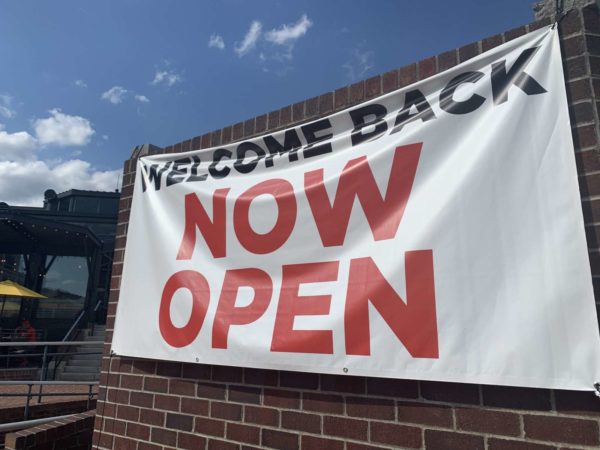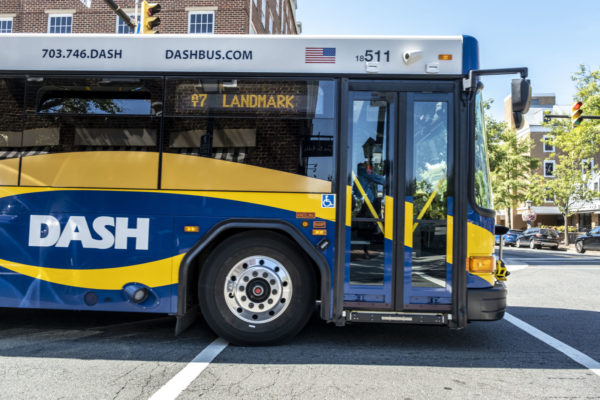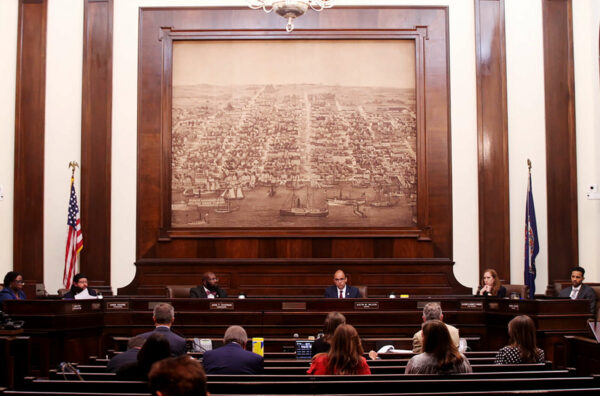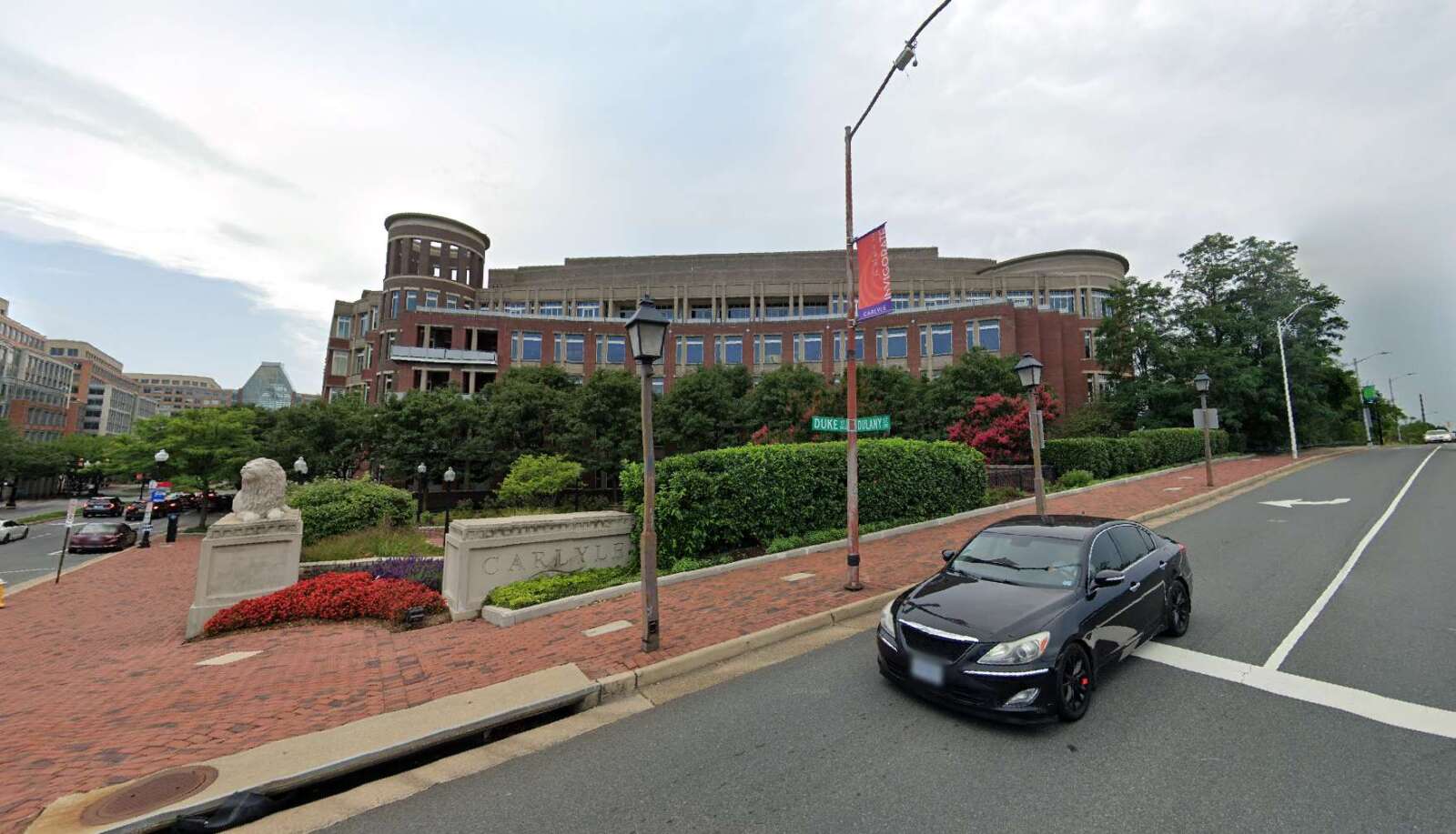
(Updated 4:40 p.m.) The large office building in Carlyle containing the Motley Fool headquarters is heading to a foreclosure auction.
The 164,407-square-foot office building has a stately appearance at the northern entrance to the Carlyle neighborhood — with the iconic lion statues out front and a distinctive circular turret design — but the building has been the victim of market upheaval since the pandemic devastated office real estate.
In 2023, building tenant Motley Fool significantly downsized its space in the building.
The Washington Business Journal reported that the building’s owner, The Shidler Group, defaulted on its mortgage of the building.
A news release said the building will be sold at a foreclosure auction on Thursday, May 16, with RealMarkets handling the sale.
“The successful bidder will own the five-story building on approximately 1.6 acres subject to a ground lease,” the release said. “The building is approximately 44 percent occupied by two full floor tenants. It features five floors, a marble lobby, entry security and 296 private underground parking spaces. The fourth and fifth floors, as well as some smaller spaces on the ground floor, are available.”
According to the release, it will sell to the highest bidder over a $500,000 minimum bid. The building sold for $57.75 million back in February 2019.
Image via Google Maps

(Updated 12/27) An economic impact report released last Friday said the new Potomac Yard arena would create 30,000 jobs and more than double the economic output of previous development plans.
The report came from HR&A Advisors, a consultant hired by the Alexandria Economic Development Partnership AEDP in June as a technical advisor.
The memo to AEDP from HR&A Advisors notes that the findings are based on Monumental Sports & Entertainment operations information shared by AEDP that shows statistics from arena and performing arts venue events.
The report looks at the economic impacts of the development, from construction impacts to economic output and tax revenue.
According to the report:
Key takeaways from this analysis are provided here, with additional detail on
methodology and findings provided in in the sections below.
- Development of an entertainment district would generate approximately 30,000 permanent jobs
for the Commonwealth of Virginia.- An entertainment district is projected to generate roughly 2.5 times the economic output of
what would otherwise be built based on current development plans.
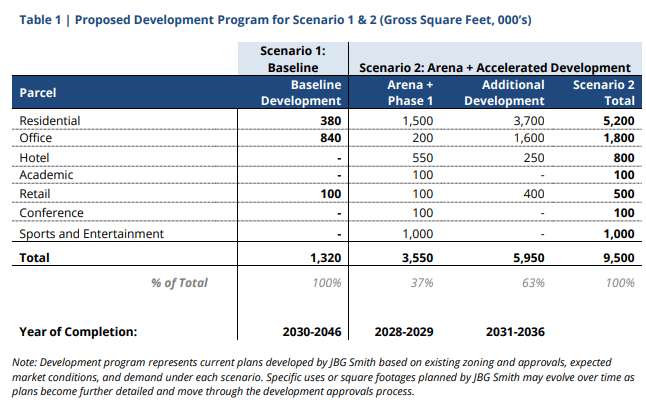
The permanent annual economic output of Potomac Yard sans arena vs Potomac Yard with the arena, according to the report, is $3.5 billion vs $8 billion. Over the next 30 years, the report says the ongoing economic output is estimated at $93.8 billion with the arena as compared to $36 billion without the arena.
Some of that revenue to the city and the Commonwealth would go to paying off debt borrowed to build the arena. According to Mayor Justin Wilson:
The debt borrowed by this public entity will be paid by three streams of money.
First: a private stream. Ted Leonsis will pay, first of all, a $400 million downpayment and a rent payment. That rent payment will be used to pay off that debt.
Second: the city will take a portion of the new tax revenue that comes from this development and we will use it to pay off a portion of this debt borrowed by that authority.
Third: the Commonwealth will take a portion of its tax revenue coming off this use and they will use it to pay off the loans used to construct it.
This is exactly the way we funded the Potomac Yard metro. We funded it using the tax increment of development that happened in Potomac Yard.
The summary is available online.
Whether the arena goes forward remains to be seen, Alexandrians were quick to raise concerns about the transportation impact and local leaders followed suit in the days after the announcement.
Six months in, participants in a new guaranteed income pilot aren’t diving into pools of money; it’s just helping them tread water a little easier.
While there aren’t restrictions on what the money can be used for, Economic Mobility Program Officer Julie Mullen said most of the money distributed in the city’s ARISE Guaranteed Income Pilot is helping those in need with basic necessities.
“Anecdotally, what we’re hearing is that $500 a month really lightens their load,” Mullen said. “We’ve gotten comments like ‘I can go to the grocery store without stressing’ and ‘I can pay the rent without stressing.'”
A single father with three children in the program was able to quit his second job, Mullen said, and spent more time at home with his children without being as worried about making ends’ meet.
“The general sense is that the mental load is lighter,” Mullen said. “Especially for single parents, we know that group, especially in Alexandria, is under a lot of strain.”
Beyond the anecdotal evidence, Mullen said a consultant is researching how $500 per month impacts economic stability, market participation, and physical and mental health. For households with children, Mullen said they’re studying how it’s impacting the kids.
“The cost of living is astronomical,” Mullen said. “These are not problems easily solved by getting a better job… we’re really dealing with a bigger systemic problem.”
By and large, Mullen said most of the spending has gone toward basics.
“The biggest spending category is grocery stores,” Mullen said. “I think that suggests people are spending the money to get through the month and pay for basic needs. I think that underscores the need for something like guaranteed income.”
Mullen said that research should be available once the program hits its one-year anniversary in February.
One of the lessons, Mullen said, was the tricky process of navigating how the pilot intersected with other programs like Medicaid and housing vouchers.
“I think when we were launching, the big question was how are people’s current benefits going to be impacted, things like SNAP and Medicaid and housing vouchers,” Mullen said. “We were spending a lot of time and energy to get benefit waivers to make sure people weren’t losing benefits they were getting.”
It was easier for the program to get some waivers than others.
“We were able to secure quite a few benefit waivers, like SNAP,” Mullen said. “Housing vouchers and Supplemental Security Income (SSI) were the big ones — there’s currently no waivers given from those.”
Mullen said her office did benefits counseling with participants before they joined so they could understand how their existing benefits might be impacted. Some decided not to participate because they didn’t want to compromise their SSI enrollment.
Similarly, some potential participants with housing vouchers decided not to participate, but those in low-income housing did participate because the program was still a net financial gain.
“On the whole, how the current benefits would be impacted is a big conversation point,” Mullen said.
Mullen said she’s been in close contact with Fairfax as Alexandria’s neighbor prepares to launch a similar program.
While the pilot is only halfway through its first year, Mullen said she’s been encouraged by the results so far.
“The excitement is that it’s lightening people’s mental load,” Mullen said, “which is what we wanted.”
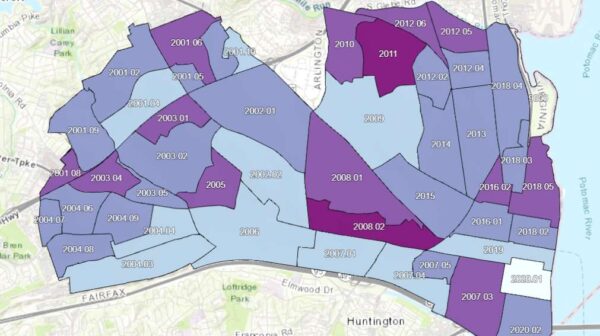
The City of Alexandria has a new tool that highlights areas where income levels vary significantly by racial and ethnic groups.
The new Equity Index Map map isn’t a chart of levels of poverty across Alexandria, as some of the wealthiest and poorest communities across Alexandria have low levels of disparity. Instead, it highlights census tracts where race and indicators of economic inequality are closely linked.
The map identifies “disparities between racial/ethnic groups in key socioeconomic outcomes” along with resources to examine the root cause of “entrenched inequities in Alexandria.”
The tool is part of a three-year-long effort by City of Alexandria’s Race and Social Equity (RASE) Office to develop more tools to examine inequalities in the city.
The map tracks things like “homeownership disparities” and “median income disparities” — the levels of inequality in terms of home ownership and income. The map is broken up along census tract lines.
Taylor Run and North Ridge are two areas the map considers to have the most severe disparities. Both census tracts ranked fairly high in poverty disparity. The map does not provide specific information about comparisons on racial/ethic lines, but the map’s racial equity index score indicates a racial element to the disparity between residents of affordable high rises along Duke Street and homeowners in the Taylor Run neighborhood within the same census tract.
The full release from the city is below:
The City of Alexandria will launch an Equity Index Map for use by City agencies, City Council, and community partners. For the last three years, the City’s Race and Social Equity (RASE) Office has been working to develop tools to promote equity throughout our community. This new resource will promote the intentional use of data to eliminate systemic and institutional inequities experienced by residents.
On Thursday, May 4, the RASE Office will launch the Equity Index Map in an interactive event, held from 2 to 4 p.m., at Alexandria Renew Enterprises, 6th Floor Conference Center, 1800 Limerick Street, Alexandria, Virginia. The launch will give participants the opportunity to explore and understand how to use the map to address real-world challenges. Please register for the event by filling out the Equity Index Map Launch Registration Form.
The two key components of the Equity Index Map — the Racial Equity Index and the Social Opportunity Indicators — capture the magnitude of disparities between racial/ethnic groups in key socioeconomic outcomes and help users explore the factors that may drive those disparities. The Equity Index Map provides users with a resource to think about the root causes of the entrenched inequities in Alexandria and how City leaders can address those root causes to achieve equity for all.
A series of opportunities will be available to engage with residents regarding the forthcoming equity resources as the City moves toward a more intentionally equitable future.
Since hiring the City’s first Race and Social Equity Officer, internal and external contributors to the City’s equity commitment have begun engaging in equity training, addressing inequities in their services, and applying an equity lens to their work to determine how to best serve all Alexandrians.
In 2021, City Council adopted the ALL Alexandria Resolution, the commitment by City leaders to race and social equity through increased knowledge, understanding, and dynamic engagement throughout our entire community. View the ALL Alexandria Resolution video.

Alexandria City Manager Jim Parajon released his proposed $881.1 million fiscal year 2024 budget at City Hall on Tuesday night, and it includes an option to raise taxes by 1 cent.
The budget also reflects $8.1 million in collective bargaining agreement funds that will go to the Fire and Police Departments.
Parajon, who presented his budget to City Council, said that unexpectedly high real estate assessments and $4.6 million in efficiency reductions wiped away a projected $17 million budget shortfall.
The budget is a 5% increase over last year’s budget, and Parajon is proposing no change in the real estate tax rate, which would remain at $1.11 per $100 of assessed value for the second year in a row. The same goes for other tax rates, including personal property taxes, which would remain at $5.33 per $100 of assessed value for vehicles and $4.75 per $100 of assessed value for tangible personal property.
Stormwater utility fee rates are, however, projected to increase from $294 to $308.70.
The budget funds the Alexandria School Board’s operating budget transfer request of $258.7 million, which is an increase of $9.9 million, or 4%.
“You’re also going to see a fairly significant emphasis on public safety and first responders,” Parajon told Council.
Parajon is also asking for $500,000 for diverse small business funding. That particular funding request comes after the city recently abandoned a grant program aimed at helping minority business owners after a lawsuit claimed the program was discriminatory against white people.
The budget provides:
- A 7% market rate adjustment for sworn fire, medics and fire marshals
- A 6% market rate adjustment for sworn police and Sheriff’s Deputies
- A 2% increase in General Schedule and Sheriff’s Deputy pay scales
- A $4.5% market rate adjustment for non-public safety personnel
- Three new steps in the general pay scale, which is a 7% increase in salary potential
- 25 SAFER grant-funded firefighters
- Funding for Commonwealth’s Attorney staffing for more than $600,000 toward the APD body worn camera program, which launches in April
Parajon asked all departments for 1.5%-to-2% in budget reductions in their proposals, with efficiencies including the outsourcing of city employee leave of absence reviews, benefits consulting, and city vehicle fleet repair.
The manager is also advising Council to consider an “alternative” 1 cent increase in real estate taxes, which would reduce borrowing for the Alexandria City High School Project, increase city employee compensation and provide an additional pay increase of 1% over what’s being proposed for city and Sheriff’s Office employees.
That 1 cent would also fund:
- An emergency services bed-finder for $79,225
- A new bilingual clinical psychologist to help city employees experiencing trauma for $166,380
- A construction project manager for $212,445
- Out of school time staffing for $200,000
- Summer youth employment expansion for $200,000
Parajon, who also presented a $2.39 billion 10-year Capital Improvement Program (CIP), proposes $367.2 million for Schools capital projects, including $39.5 million in cost escalations for projects currently underway like the George Mason Elementary School project.
The FY 2024-2032 CIP includes:
- $282 million for the city’s stormwater management systems
- $185.1 million for the Washington Metropolitan Area Transit Authority’s capital program
- $63.3 for citywide street reconstruction and repaving
- $48.2 for capital infrastructure improvements associated with the Waterfront Implementation Project
- $17.4 million to renovate Four Mile Run Park
“I certainly look forward to working alongside my colleagues as we spend the next next few months engaging with the community to provide a budget,” said Mayor Justin Wilson.
There will be multiple public forums to discuss the budget, the next being a public presentation by Parajon on Thursday, March 2 at 7 p.m. at Charles E. Beatley, Jr. Central Library (5005 Duke Street), followed by a City Council/School Board budget work session on Wednesday, March 8, and budget public hearings on March 13 and March 18.
The budget will be approved on May 3 and go into effect on July 1.
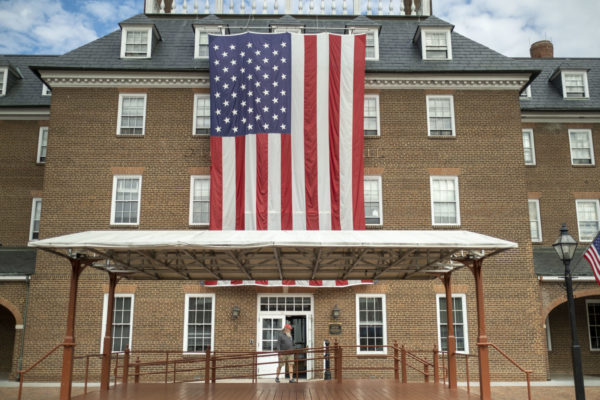
At a City Council retreat, Alexandria leaders met with some of the city’s leading budgetary advisors to discuss some dire signs of what one staff member called a “pasta bowl recession.”
The city’s top finance experts said the city should be cautious as it potentially heads into a period of stagnant economic growth — if not outright decline.
“We don’t want to take a doom and gloom approach,” said Director of Finance Kendel Taylor. “We’re not saying the sky is going to fall, but we actually don’t know. The uncertainty where everyone is sitting right now is fairly significant.”
Taylor said that, as the city begins to plan for Fiscal Year (FY) 2024, the Department of Finance is being cautious.
“When we look at FY 2024: it’s very early,” Taylor said. “We only have a couple months of sales tax… interest rates keep going up, fuel prices, there’s a lot of uncertainty. We’re in a very cautionary stage.”
While the city’s economy is continuing to grow, Taylor said that’s going more slowly than she’d like. While the city averages 4% economic growth, Taylor said her office is estimating only a 2% change.
“We’re still an attractive place to live, we’re still economically sound, but it’s not what it’s been for the last few years,” Taylor said. “We’ve seen a lot of growth in the past year… but really we’ve just gotten back to pre-pandemic levels. That means we missed two years of anticipated growth. It’s a weird environment… It’s something where we have to just be cautious.”
Along with that slow growth, Taylor said interest rates have gone from 3% to 7%, meaning it’s more expensive to buy a house in Alexandria today than it was a year ago.
Vehicle assessments, meanwhile, remain high. The city approved a one-time tax relief for car owners to keep their tax from skyrocketing after vehicle values shot up during the pandemic. Taylor said the city is still monitoring those values this year to see if a repeat of that one-time relief might be needed.
“It’s too early to really know what’s going to happen with vehicles, but values remain high,” Taylor said. “We made an assessment adjustment in 2022 to mitigate those increases. We’re going to keep watching that over the next few months to see what’s the right approach to vehicle values in 2023.”
In brighter news, Taylor said sales tax and meals tax figures have remained strong, exhibiting a commitment from the community to supporting local restaurants and businesses. Those tax levels were restored to pre-pandemic levels in the summer of 2021.
The hotel tax has slowly been crawling back. Taylor said in July the city was within 10% of where the hotel tax was pre-pandemic. In August, it was within less than 1% of pre-pandemic levels.
At the same time, Taylor warned that optimism over tax levels returning to pre-pandemic levels ignores the bigger concern that the city has still lost two years of economic growth.
“It’s great to see that hotels are getting back to pre-pandemic levels,” Taylor said, “but we would have typically seen a few percentage points of growth.”
Kevin Greenlief, assistant director of finance, said the revenue from FY22 was good and FY23 has revenue increases baked into it, but the keyword for FY24 is caution.
“In the second quarter of 2022, [chief financial officers] are beginning to be pessimistic about GDP growth and potential impacts of a recession,” Greenlief said. “The popular term right now is a pasta bowl recession’: a long recession but not a deep one. I’ve seen ranges from a -.4% GDP growth to a .1% positive growth. There’s a lot of debate right now about whether there will be a recession. The smart money seems to think so, but they’re not looking like the sky is falling, it’s that [growth] is going to be flat.”
As the city plans for the future, City Manager Jim Parajon said some of that will involve looking at how much office conversion the city allows. While the city has had numerous positive office conversions — from restaurants to schools — Parajon also warned against throwing the baby out with the bath water. Maintaining some level of office space could be the better long-term play, even if it means losing some revenue short-term.
“The conversion approach for outdated office makes a lot of sense, but I want to be careful that we don’t lose good office space to conversion,” Parajon said. “That’s really important, and that may mean we play out a cycle or two in the economy so we’re looking at a balance of commercial to residential.”
Even when offices do come back, Parajon said they may not resemble the sea of cubicles from the pre-pandemic days.
“We’re likely to see smaller footprint office components with lifestyle office elements,” Parajon said. “They all feed really well into Alexandria because we have an amazing lifestyle here and that’s enticing to a company that needs to recruit and retain talent.”
As the Alexandria Economic Development Partnership works through programs aimed at helping to strengthen the city’s business communities post-Covid, some in the organization and partnering groups are working to ensure there’s a greater diversity of voices in the new order.
A new grant program, the ALX B2B Business Association Grant Program, aims to help prop up business associations across the city to make them more active and helpful for their communities. The city-funded grant program is in the process of distributing $535,000 in grant funding across eight associations.
AEDP Economic Recovery Manager Senay Gebremedhin and Kevin Harris, former City Council candidate and head of the new Alexandria Minority Business Association, said the goal of the grant program is in part to use the pandemic recovery to help address issues around diversity that predate and were exacerbated by Covid.
Gebremedhin said AEDP’s goal is to use the funding as a boost to business associations to get them to a place where they can be healthy and independently sustainable long-term, without relying on backing from pandemic recovery funding to provide higher levels of service.
“When we built out the program, we intentionally built out sustainability as a core purpose,” Gebremedhin said. “The funding was short-term, so applicants had an understanding that they needed to continue services beyond the funding period.”
The grant funding is going to eight different organizations, ranging from established groups like the Alexandria Chamber of Commerce to brand new organizations like Harris’ Alexandria Minority Business Association.
- Alexandria Chamber of Commerce
- Alexandria Minority Business Association, Inc.
- Del Ray Business Association
- Eisenhower Avenue Public-Private Partnership
- Old Town Business Association
- Old Town North Alliance
- Social Responsibility Group
- West End Business Association (WEBA)
Many of the organizations have been volunteer-led, and Gebremedhin said in the past they’ve struggled to sustain initiatives without proper funding or infrastructure support. Even among the more established organizations, Gebremedhin said nearly all of them have seen leadership turnover in recent years.
While the program distributes funding to regional associations like the Del Ray Business Association, the new Social Responsibility Group and the Alexandria Minority Business Association target specific issues within the sphere of local economic development. Gebremedhin said the Social Responsibility Group works with AEDP on communications with local business incubators.
“One of the priorities for our group is creating peer relationships,” Gebremedhin said. “The Social Responsibility Group has a much broader agenda, but our work is narrowly focused with them on one of the pillars of their agency… incubators and building resources for emerging businesses in Alexandria.”
According to Harris, not all businesses have been able to participate in influential policy discussions between the city and the business community. He said he hopes the Alexandria Minority Business Association gives new minority voices a similar chance to weigh in.
“When things are rolled out, there is some communication with other business associations to weigh in on how things are rolled out,” Harris said. “There is a need for that in the minority community.”
Alexandrians making less than half of the region’s area median income could qualify for a new program that will give them $500 per month with no strings attached.
Those living alone and making less than $49,850 per year are eligible, with the income scaling up based on the size of the household.
The program, Alexandria’s Recurring Income for Success and Equity (ARISE), was funded as part of the city’s Covid recovery.
During the pilot phase, 170 randomly selected individuals who meet certain household income limits will be selected. Those selected will be provided with $500 every month for 24 months to spend in any way they choose.
“Guaranteed income pilots have proven to impact poverty and economic inequity by enabling participants to determine for themselves the budgetary strategies that will most benefit them and their families,” the city said in a release. “ARISE will help the city test a bold, new way to ensure people have what they need to make decisions to support their well-being.”
With Labor Day coming up on Monday, a couple of the leading unions and labor organizing groups in Alexandria say they’ve seen substantial gains but there’s still work to be done.
Collective bargaining for public safety agencies was one of the leading issues early in late 2021 and early 2022. Labor activists were also critical of the city’s involvement in financing the development of the Hotel Heron in Old Town, saying the city should leverage its position to ensure better wages and treatment of employees.
In recent years, Alexandria labor activists have also worked with human rights advocates in protests against evictions and poor living conditions.
NoVa Labor
The Northern Virginia Labor Federation (NoVA Labor) is an umbrella organization that encompasses unions in all segments of the economy. Virginia Diamond, President of the NoVA Labor, said the organization includes 55 different labor organizations and 70,000 members across the state.
Diamond said union organizing is on the rise as Virginia’s workforce grapples with the economic impact of the pandemic.
“This year NoVA Labor has seen a great upsurge in union organizing,” Diamond said. “This is a result of the impact of the pandemic on workers, as well as a generational revolt against an economy that offers young workers little hope for the future.”
Alexandria in particular has been at the forefront of union organizing in Virginia, Diamond said.
“Alexandria is a progressive community that values equity and economic justice, so there is widespread support for unions,” Diamond said. “When the General Assembly adopted a statute enabling localities to allow public employees to engage in collective bargaining, Alexandria was the first locality in Virginia to adopt such an ordinance.”
Diamond said one of the major labor concerns is wage theft and exploitation in the construction industry.
“Soon the City will address this problem by adopting a prevailing wage and using community benefit agreements, also known as project labor agreements,” Diamond said.
Beyond combatting wage theft, Diamond said one of the critical pieces of labor reform is offering low-income communities in Alexandria better access to higher-paying trades and careers.
“Building trades unions are reaching out to low-income communities in Alexandria to offer free paid apprenticeships leading to middle-class careers in the skilled trades,” Diamond said. “The Alexandria Democrats Labor Caucus, headed by Russ Davis and Sean Casey, bring together union members and friends of labor to publicize and educate the community on issues affecting workers.”
Diamond said a driving force behind union organizing is the dire levels of income inequality.
“Income inequality is at a level of the Gilded Age, and unionization in the private economy is at only 6%, down from 34% four decades ago,” Diamond said. “Income inequality is a grave concern to Alexandrians, and the most important vehicle for addressing this inequality is unionization. Just as factory workers in the 1930’s and ’40’s organized and built the middle class, workers in the service economy are now organizing to rebuild the middle class.”
Diamond said she’s encouraged by union victories at companies like Starbucks, Amazon, Apple, Chipotle, REI and Trader Joe’s:
The popularity of unions is now at 71%, higher than any time since the 1960’s. The resurgent labor movement is just getting started. Hopefully over the next year we will see the first union hotel, the first union Starbucks, and the first union health care facilities in Alexandria. With the support of the Alexandria community and city leaders, workers will achieve the dignity, respect and living standards that they deserve. Good jobs are union jobs, and good union jobs will enable workers to afford to continue to live in this community.
(Updated 12/14) Remember the American Rescue Plan Act? Earlier this year, the city received $29.8 million in funding to allocate toward projects across the city.
Five months later, a new report to the City Council scheduled to be presented at a meeting tomorrow breaks down how that’s been going so far. Here is ALXnow’s simplified, condensed version:
Digital Accessibility
- Digital Equity Plan (funding: $120,000): The city has been working on developing a digital equity plan that will identify infrastructure, device, and digital literacy barriers in Alexandria. This is part of an overarching goal spread out across a few ARPA projects to make internet access more equitable throughout the city. The report said by the end of January a community help desk should be in operation and a consultant should be under contract to start work on the plan.
- Broadband Strategist and Policy Analyst (funding: $300,000): The city is looking to hire someone focused on community outreach for the new municipal fiber network program, as well as assisting in addressing equitable digital access. The city is currently finalizing the job announcement, with posting and recruitment by the end of January.
- Alexandria Library Mobile Hotspot Lending Program (funding: $20,000): The libraries have been working with Verizon to deliver mobile hotspots to library cardholders as part of a plan to increase internet accessibility in Alexandria. The goal is to have all mobile hotspots in circulation to library cardholders by the end of January.
Housing and Food Security
- Eviction protection program (funding: $200,000): The city is currently hiring a second housing justice attorney to support ongoing eviction prevention data analysis and planning efforts.
- Rental resiliency (funding: $312,000): Bilingual staff were working this fall with tenants and landlords to help with access to emergency resources, with the end goal of maintaining long-term housing stability and security. Outreach and assistance is planned to continue through 2024.
- Food security advancement (funding: $2.5 million): In an effort at addressing food insecurity exarcerbated by the pandemic, the city is putting together a plan to create food centers for those in need and continue food distribution. The report says the first food center location is identified and close to opening.
- AHDC-Arlandria flex space (funding: $2 million): The Alexandria Housing Development Corporation is using ARPA funding to expand city services in Arlandria, creating a satellite flex space within an AHDC project that would house Housing/Landlord-Tenant, DCHS, and AHD offices. The plan is currently working through meetings to assess agency needs and space requirements.
- Arlandria Chirilagua Housing Cooperative Improvement Initiative (funding: $50,000): The funding is scheduled to go to a loan/grant assistance program to help the Arlandria Chirilagua Housing Cooperative make capital improvements to buildings and improve living conditions for 286 very low-income households in Arlandria. The city is working through the red tape and finalizing a report outlining the priorities and budget of the program.
- Bridge funding for food insecurity and basic needs (funding: $1.5 million): The city has been using ARPA funding to help with food insecurity and eviction prevention. Over 69,000 locals recieved meal equivalents through the funding this year and the funding went to help eviction preventino and support for 405 households and 1003 individuals. The city has been working with nonprofits like ALIVE!, Ethiopian Community Development Corporation and Tenants and Workers United.
Economic Recovery
- Foundational support for Commercial Business Districts (funding: $560,000): After being struck down a few years back, the idea of a Business Improvement District snuck back into the ARPA plans with a program aimed at assisting in the immediate and long-term financial recovery for businesses. The program guidelines were being revised in the fall to provide multi-year funding.
- North Old Town Community Development Authority (funding: $500,000): The Alexandria Economic Development Partnership is using this ARPA funding to start building a legal structure to take ownership for artistic facilities in North Old Town. A project manager is planned to be onboarded by the end of January with initial legal documents and contracts drawn up.
- New business support programs (funding: $280,000): This project will support the creation of new businesses and jobs by offering counseling support, but it’s still under development with a project manager likely to be hired early next year.
- Alexandria guaranteed basic income pilot (funding: $3 million): This program was in the headlines for providing a monthly $500 cash transfer on a pre-loaded debit card to around 150 families for 24 months. The pilot program has been going through analysis by researchers at Howard University. The program has also hit some snags in the research partner process. A formal rollout is expected by January 31, 2022 with the distribution of funds starting in February.
- Expanding regional marketing (funding: $500,000): The Alexandria marketing is scheduled to boost regional visitation and small business recovery, with a particular focus on supporting “visitors and entrepreneurs of color.” The advertising videos and photography has been completed and is being developed.
- Alexandria Community Access and Emergency Support Grant Program ($4 million): The single largest chunk of the ARPA funding is going to a grant program that provides support for non-profit partners, giving those non-profits grant funding to continue collaborative efforts in the city. The program is broken up into different portions that cover community access — helping connect local, state and federal services to those in need — and emergency support — which offers emergency financial resources to low-income residents who aren’t eligible for government-sponsored programs or fall outside the need of those programs. The grants have been awarded and services will begin being delivered by the end of next month.
- Re-employment and upskilling project (funding: $1.1 million): The city has created employment and training specialist positions and recruited over the last month. The city is now working to engage community stakeholders for more support, referrals, and placement for those seeking jobs. The plan is to have the first group of Alexandria residents in the program vetted and enrolled by the end of January.



